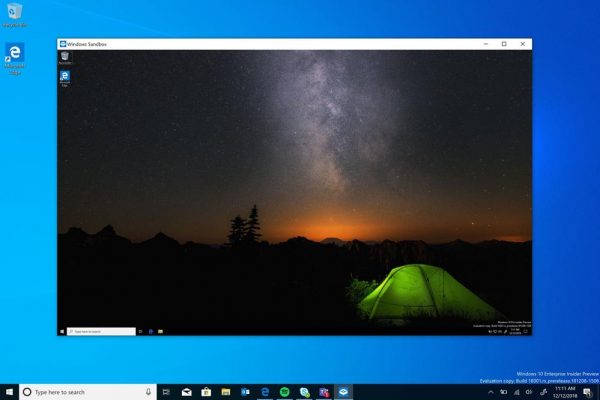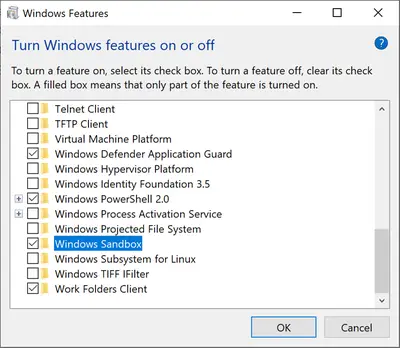The most popular way to run suspicious code on a device is by tricking in the user to install a suspicious program on the targeted device. Lack of awareness among the user base regarding these kinds of threats leaves a device vulnerable to a certain kind of threat always. But it looks like Microsoft has been working hard in the background in order to address this issue. They have just announced the availability of a sandboxed version of Windows 11/10 running inside Windows 11/10 just to isolate the suspected software running inside it, saving the main system from potential threats.

Windows Sandbox makes your computer secure
Windows Sandbox is a virtual, disposable environment that can be enabled. This means that if you suspect any suspicious software, you can run it compounded in an isolated environment and make sure that it does not interfere with any normal processes or compromise any useful files.
As mentioned,
“Windows Sandbox is a new lightweight desktop environment tailored for safely running applications in isolation.”
Once this Sandbox is closed, all the software, residual files, and other data are permanently deleted.

Windows Sandbox has the following properties:
- Part of Windows – everything required for this feature ships with Windows 10 Pro and Enterprise. No need to download a VHD!
- Pristine – every time Windows Sandbox runs, it’s as clean as a brand-new installation of Windows
- Disposable – nothing persists on the device; everything is discarded after you close the application
- Secure – uses hardware-based virtualization for kernel isolation, which relies on Microsoft’s hypervisor to run a separate kernel which isolates Windows Sandbox from the host
- Efficient – uses integrated kernel scheduler, smart memory management, and virtual GPU
One would need to meet the following minimum requirements in order to run Windows Sandbox:
- Windows 11/10 Pro or Enterprise build 18305 or later
- AMD64 architecture
- Virtualization capabilities enabled in BIOS
- At least 4GB of RAM (8GB recommended)
- At least 1 GB of free disk space (SSD recommended)
- At least 2 CPU cores (4 cores with hyperthreading recommended).
Read: Windows Sandbox failed to start.
How to enable Windows Sandbox on Windows 11/10
To enable and run Windows Sandbox on Windows 11/10, the following need to be done:
- Search for windows features in the Taskbar search box.
- Click on the individual search result.
- Tick the Windows Sandbox checkbox.
- Click the OK button.
- Let it install automatically.
- Restart your computer.
Let us look at this in more detail.
First, you need to make sure that you are running either of Windows 11/10 Pro or Windows 11/10 Enterprise Editions.
Then you need to enable Virtualization to let another instance of Windows 11/10 running in Sandbox mode.

After that, search for windows features or Windows Features on and off on the Search Box and select the appropriate entry, and click on the individual search result.
From the list, you get in the mini window, tick the Windows Sandbox checkbox and finally click on OK button.
Windows 11/10 might take a few moments to install the new feature. Once done, you need to restart your computer. Now, search for Windows Sandbox in the Taskbar Search box and select the appropriate entry to run it in an elevation.
From your main computer (host) copy the executable file and paste it inside the Windows Sandbox environment.
Finally, run the executable file in the Sandbox environment and use it as you would normally.
When you are done, just close the Windows Sandbox application and every data regarding that and the temporary environment will be deleted.
Just for the sake of safety, make sure that no modifications were made to the host because of the executions in the Sandboxed environment.
How do I enable sandbox in Windows 11 Home?
As of now, there is no official support for Sandbox for Windows 11/10 Home edition. However, there are some methods that you can follow to turn on Sandbox in Windows Home.
Related: Windows Sandbox has no Internet connection
How do I get to Sandbox on Windows 11?
To enable Sandbox on Windows 11/10, open the Windows Features panel on your computer and tick the Windows Sandbox checkbox. After that, it will be installed automatically on your computer. Finally, restart your computer and open the Windows Sandbox app by searching for it in the Taskbar search box.
Read:
- How to enable Windows Sandbox in VirtualBox guest OS
- How to enable Windows Sandbox in VMware Workstation
- How to enable Audio Sandbox in Edge browser.
Contact Microsoft for feedback related to Windows Sandbox
You can use the traditional Feedback Hub if you have any issues or suggestions.

Fill in the appropriate details and for the feature category, select Windows Sandbox under Security and Privacy.
If you have any issues related to the execution of and within Windows Sandbox, select Recreate my problem.
Select Start capture to reproduce the issue and when done, select Stop capture,
This is how you can send feedback to the appropriate team.
Read next: How to configure and use Windows Sandbox. You can also use Sandbox Configuration Manager.
Wouldn’t it be cool to save the app state when the sandbox is closed and to resume the app state when opening a saved sandbox?
Then you can virtualize apps/programs with gui like docker can do this with headless apps.
No Sandbox love. Everything properly set in BIOS, Windows 10 Pro 18305 and 8700K Intel Virtualization enabled in BIOS, Hyper V enabled, Windows Sandbox enabled. High end everything with clena install 2 months ago – also have VB 6.0 installed – says it is compatible with Sandbox.
I see the blue sandbox logo start and disappear and that’s it. Not running in task manager. Thoughts?
The feature is still in beta. You can report it to the feedback hub.
There’s a bug within a patch for Internet Explorer that has broken Sandbox for now.